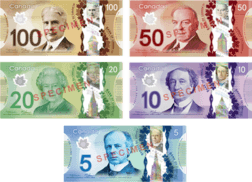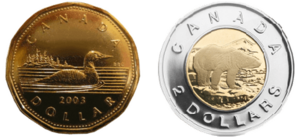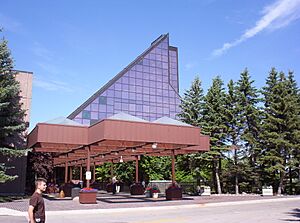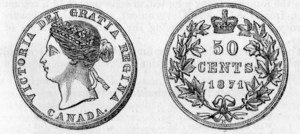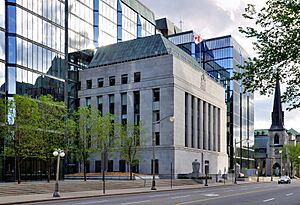Canadian dollar facts for kids
Quick facts for kids Canadian dollar |
|||
|---|---|---|---|
|
|||
| ISO 4217 Code | CAD | ||
| Official user(s) | Canada | ||
| Unofficial user(s) | St. Pierre and Miquelon | ||
| Inflation | 2.7% (June 2024) | ||
| Source | Statistics Canada | ||
| Method | Consumer price index | ||
| Subunit | |||
| 1⁄100 | Cent and sou (colloquial in French) |
||
| Symbol | $ | ||
| Cent | ¢ | ||
| Nickname | Loonie, buck Huard, piastre (pronounced piasse in popular usage) |
||
| Coins | |||
| Freq. used | 5¢, 10¢, 25¢, $1, $2 | ||
| Rarely used | 1¢ (discontinued, still legal tender), 50¢ (still minted) | ||
| Banknotes | $5, $10, $20, $50, $100 | ||
| Printer | Canadian Bank Note Company | ||
The Canadian dollar (symbol: $; code: CAD; French: dollar canadien) is the official money of Canada. You'll often see it written with the dollar sign $. To tell it apart from other types of dollars, people often use abbreviations like Can$, CA$, or C$. One Canadian dollar is made up of 100 cents (¢).
Because the Canadian one-dollar coin has a picture of a common loon bird on it, people in Canada and currency traders often call the coin, or even the currency itself, a loonie. The Canadian dollar is also known as the "buck."
The Canadian dollar is a very important currency around the world. As of 2024, it's the seventh most held reserve currency. This means many central banks in other countries keep Canadian dollars as part of their savings. They like it because Canada has a strong economy and a stable government.
Contents
How Canada's Money Started
Early Money in Canada
Before Canada became a country, its different provinces used various types of money. In the 1850s, there was a big discussion about whether to use a money system based on the British pound or a decimal system like the U.S. dollar.
The provinces wanted to use a dollar system because they traded a lot with the United States. However, the British government in London preferred that everyone in the British Empire use the British pound. Even so, the Canadian provinces slowly started using currencies that were linked to the American dollar.
| Currency | Years Used | Value in Canadian Dollars |
|---|---|---|
| Canadian pound | 1841–1858 | $4 |
| Canadian dollar | 1858–present | $1 |
| New Brunswick dollar | 1860–1867 | |
| British Columbia dollar | 1865–1871 | |
| Prince Edward Island dollar | 1871–1873 | |
| Nova Scotian dollar | 1860–1871 | $0.973 |
| Newfoundland dollar | 1865–1895 | $1.014 |
| 1895–1949 | $1 |
Province of Canada's Dollar
In 1841, the Province of Canada (which included parts of modern-day Ontario and Quebec) created a new money system. It was based on the "Halifax rating." This new Canadian pound was worth four U.S. dollars.
By 1857, the decision was made to introduce a decimal currency in the Province of Canada. This new money would be linked to the U.S. dollar. So, when the first decimal coins came out in 1858, Canada's money became similar to the U.S. currency.
Other Colonies' Money
In 1860, New Brunswick and Nova Scotia also started using a decimal system based on the U.S. dollar.
Prince Edward Island followed in 1871, introducing its own 1-cent coins. However, when Prince Edward Island joined Canada in 1873, its money became part of the Canadian system.
Newfoundland started using a decimal system in 1865. Its dollar was based on the Spanish dollar, which was slightly different from the U.S. dollar. So, the Newfoundland dollar was worth a little more than the Canadian dollar until 1895.
The Colony of British Columbia also adopted its own dollar in 1865, which was equal in value to the Canadian dollar. When British Columbia joined Canada in 1871, the Canadian dollar took over.
After Canada Became a Country
In 1867, the Province of Canada, New Brunswick, and Nova Scotia joined together to form Canada. Their different currencies then became one single Canadian dollar. In 1871, the Canadian Parliament passed a law called the Uniform Currency Act. This law made sure all provinces used the same Canadian dollar.
Canada stopped using the gold standard (where money's value is tied to gold) during World War I. It was completely removed on April 10, 1933.
During World War II, the Canadian dollar's value was set at Can$1.10 for every US$1.00. This changed to an equal value in 1946. In 1950, Canada let its dollar "float," meaning its value could change based on the market. For the next ten years, the Canadian dollar was actually worth a little more than the U.S. dollar!
However, the Canadian dollar dropped a lot after 1960. In 1962, its value was again fixed at Can$1.00 for US$0.925. This fixed rate lasted until 1970, and since then, the Canadian dollar has been floating freely.
Names for Canadian Money
Canadians use the slang term "buck" for a dollar, just like in the U.S. This word comes from the 17th century, when the Hudson's Bay Company used a coin worth one male beaver pelt, called a "buck."
When the one-dollar paper bill was replaced by a coin in 1987, the coin had a picture of a common loon on the back. So, people started calling the $1 coin a loonie. Later, when the two-dollar coin was introduced in 1996, it was nicknamed the toonie ("two loonies").
In French, the currency is also called le dollar. Some French-Canadian slang terms include piastre or piasse (an old word for "dollar") and huard (which is French for "loon," like on the coin). For cents, people often say cent or informally, sou.
Sometimes, 25-cent coins in Quebec French are called trente sous ("thirty cents"). This is because of old changes in money and exchange rates. Long ago, 25 cents was equal to 30 halfpence, which were called sous. Even though the money changed, the nickname stuck!
Canadian Coins
The Royal Canadian Mint makes all Canadian coins. They have facilities in Winnipeg, Manitoba, and Ottawa, Ontario.
The coins you'll see are:
- 5¢ (nickel)
- 10¢ (dime)
- 25¢ (quarter)
- 50¢ (50¢ piece) – these are rare in everyday use.
- $1 (loonie)
- $2 (toonie)
The last 1¢ coin (penny) was made in 2012. Since 2013, stores round cash payments to the nearest five cents. You can still use pennies to pay, but you won't get them back as change.
Most Canadian coins have Canadian symbols, often wildlife, on the back. The front of the coins shows a picture of Charles III. You might also find older coins with Elizabeth II or even George VI. Sometimes, you'll even find U.S. coins mixed in because they are similar in size and color.
Coin History
In 1858, the Province of Canada issued 1¢, 5¢, 10¢, and 20¢ coins. More coins, including 25¢ and 50¢, were introduced in 1870.
Canada also made its first gold dollar coins in 1912, in $5 and $10 amounts. These coins were made from 1912 to 1914. Much of the gold came from the Klondike River valley in the Yukon. Production stopped during World War I to control gold reserves.
Over the years, the materials used for coins changed. In 1920, the 1¢ coin became smaller. The silver content in 5¢, 10¢, 25¢, and 50¢ coins was reduced. In 1922, the silver 5¢ coin was replaced by a larger nickel coin.
During World War II, nickel was needed for the war effort. So, the 5¢ coin was made from tombac (a type of brass) and changed from round to a twelve-sided shape. Later, steel was used for the 5¢ coin. Nickel was used again after the war, and the 5¢ coin became round again in 1963.
In 1967, the silver content in 10¢ and 25¢ coins was further reduced. By 1968, all circulating silver coins were replaced with nickel ones. This was the last year silver coins were made for everyday use in Canada.

In 1982, the 1¢ coin became twelve-sided. In 1987, the $1 coin (the loonie) was introduced, made of nickel with a gold-like plating. The bimetallic $2 coin (the toonie) followed in 1996. This coin has two different metals.
In 1997, the 1¢ coin changed to copper-plated zinc and became round again. Then, in 2000, even cheaper steel coins were introduced for 1¢, 5¢, 10¢, 25¢, and 50¢. In 2012, the $1 and $2 coins also started using this layered steel technology. That same year, making 1¢ coins stopped, and they began to be removed from circulation in 2013.
Canadian Banknotes

The first paper money in Canada was issued by the British Army between 1813 and 1815. Later, private banks and colonial governments also printed Canadian dollar banknotes. After Canada became a country, the Canadian government started issuing its own notes in 1870.
On July 3, 1934, the Bank of Canada was created. This new government organization became the only place that could issue federal banknotes. In 1935, it released its first series of notes in many values, from $1 to $1000. The $25 note was a special one to celebrate King George V's Silver Jubilee. In 1944, private banks were no longer allowed to print their own money.
Since 1935, Canadian banknotes have changed their designs many times. New series were introduced in 1937, 1954, 1970, 1986, and 2001. In 2011, Canada started using new notes made from polymer (a type of plastic) instead of cotton. The $100 bill was the first polymer note in 2011, followed by the $50 in 2012, and the $20, $10, and $5 notes in 2012-2013.
All banknotes are printed by the Canadian Bank Note Company in Ottawa. Older paper banknotes are no longer good for circulation because they don't have modern security features. Banks send them back to the Bank of Canada to be destroyed. However, individuals can keep these old banknotes as collectibles.
What is Legal Tender?
"Legal tender" means money that is officially recognized for paying debts. As of January 1, 2021, some older banknotes (like the $1, $2, $25, $500, and $1000 notes) are no longer legal tender. However, most other Canadian dollar banknotes are still legal tender.
Even if money is legal tender, stores in Canada can refuse certain banknotes. For example, a store might not accept a $100 bill if they are worried about fake money. The way you pay for things should be agreed upon by both you and the store.
Canadian dollars, especially coins, are sometimes accepted by businesses in northern U.S. cities. Also, some Canadian businesses accept U.S. dollars.
In 2012, Iceland thought about using the Canadian dollar as its own currency. They liked Canada because it's a northern country with a similar economy. However, Iceland decided not to do this.
How the Dollar's Value Changes
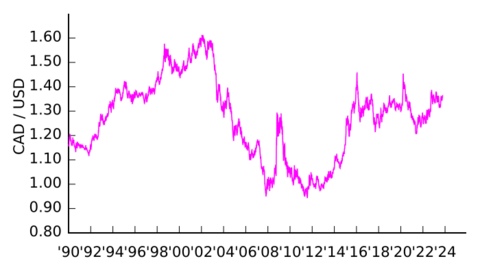

Canada trades a lot with the U.S. Most of Canada's exports go to the U.S., and most of its imports come from the U.S. So, Canadians are very interested in how their dollar compares to the U.S. dollar.
When the Canadian dollar gets stronger, Canadian products become more expensive for U.S. buyers. This can be tough for Canadian businesses that export goods. But a stronger dollar also means it's cheaper for Canadian companies to buy materials from other countries.
The Bank of Canada doesn't have a specific target value for the Canadian dollar. It believes the market should decide its worth.
Historically, the Canadian dollar often moved in a similar way to the U.S. dollar. However, between 2002 and 2013, the Canadian dollar got stronger against both the U.S. dollar and other international currencies. In recent years, the Canadian dollar's value has often changed with oil prices. This is because Canada exports a lot of oil, making its dollar a "petrocurrency."
The Canadian dollar was allowed to "float" (its value could change freely) from 1950 to 1962. Between 1952 and 1960, it was actually worth a little more than the U.S. dollar!
The Canadian dollar's value dropped a lot after 1960. This was one reason why Prime Minister John Diefenbaker lost the election in 1963. In 1962, the dollar's value was fixed again at US$0.925. This lasted until 1970.
To fight inflation (when prices go up), the Canadian dollar was allowed to float again in 1970. Its value went up, and it was worth more than the U.S. dollar for some of the 1970s. On April 25, 1974, it reached its highest point at US$1.0443.
The Canadian dollar's value fell against the U.S. dollar in the 1990s. On January 21, 2002, it hit an all-time low of US$0.6179. Since then, its value has risen against most major currencies until 2013. This was partly because of high prices for goods like oil that Canada sells.
In 2007, the Canadian dollar's value rose sharply. On September 20, 2007, it was worth the same as the U.S. dollar for the first time since 1976. On November 7, 2007, it reached US$1.1024, a modern high. This happened after China said it would use less U.S. dollars in its savings.
Because of its rising value, the Canadian dollar was named the Canadian Newsmaker of the Year for 2007 by Time magazine.
Since the late 2000s, the Canadian dollar's value has been similar to what it was before its big rise in 2007. For most of the 2010s, one Canadian dollar was worth about US$0.70.
Reserve Currency
Many central banks and commercial banks around the world keep Canadian dollars as a reserve currency. This means they hold it as a safe investment. The Canadian dollar is seen as a reliable currency.
In the Americas, the Canadian dollar is important for banking in many Caribbean countries. It's also held by central banks in Central and South America.
By watching how the Canadian dollar changes against the U.S. dollar, experts can learn things about the U.S. economy. The Canadian dollar has become a global reserve currency since the 1970s, when its value was allowed to float freely.
See also
 In Spanish: Dólar canadiense para niños
In Spanish: Dólar canadiense para niños
- Economy of Canada
- List of countries by leading trade partners
- List of the largest trading partners of Canada
Images for kids


